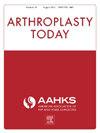初次全膝关节置换术12个月无骨水泥胫骨固定恢复较慢,但效果相同
IF 2.1
Q3 ORTHOPEDICS
引用次数: 0
摘要
背景:人们对无骨水泥一期全膝关节置换术(TKA)重新产生了兴趣,相信机器人技术可以实现更精确的骨准备和无骨水泥固定将提高生存率,特别是对年轻患者。我们进行了这项研究,以探讨使用现代设计的原发性TKA的无骨水泥胫骨固定的早期恢复轨迹。方法回顾性分析164例倾向评分匹配的原发性全髋关节置换术患者,采用骨水泥或非骨水泥胫骨假体进行反向混合。比较两组患者术后前12个月的膝关节损伤和骨关节炎预后评分、牛津膝关节评分、遗忘关节评分-12、满意度和功能预后指标,包括活动范围、坐立测试、起身和行走时间、单腿站立、小腿抬高和步数。结果骨水泥胫骨假体患者在3个月和6个月时的膝关节损伤和骨关节炎预后评分(Outcome Score)得分均高于其他患者,差异有统计学意义。到12个月时,患者报告的结果测量没有差异,总体满意度相似。在活动范围和功能结果、平均住院时间、并发症、输血、再入院或再手术方面,反向混合和骨水泥胫骨固定没有差异。两组都没有失败或修改。结论:在术后3 - 6个月,无骨胫骨固定导致患者报告的预后指标改善较慢。应告知计划进行无骨水泥胫骨固定的患者,他们在前6个月的恢复可能不如骨水泥固定那么快。本文章由计算机程序翻译,如有差异,请以英文原文为准。
Cementless Tibial Fixation Results in Slower Recovery but Equivalent Outcome at 12 months in Primary Total Knee Arthroplasty
Background
There is renewed interest in cementless primary total knee arthroplasty (TKA), driven by belief that robotics achieve more precise bone preparation and cementless fixation will improve survivorship, particularly in young patients. We undertook this study to investigate the early recovery trajectory of cementless tibial fixation using a contemporary design in primary TKA.
Methods
One hundred and sixty-four propensity score-matched patients who underwent primary TKA with either cemented or reverse hybrid using cementless tibial components were retrospectively analyzed. Knee Injury and Osteoarthritis Outcome Score, Oxford Knee Score, Forgotten Joint Score-12, satisfaction and functional outcome measures including range of motion, sit to stand test, timed up and go, single leg stance, calf raises, and step count were compared between the 2 patient groups during the first 12 months postoperatively.
Results
Patients with cemented tibial components had superior Knee Injury and Osteoarthritis Outcome Score scores at 3 and 6 months which was statistically significant. By 12 months, there was no difference in patient-reported outcome measures and overall satisfaction was similar. There was no difference between reverse hybrid and cemented tibial fixation in terms of range of motion and functional outcomes, mean length of stay, complication, blood transfusion, readmission, or reoperation. There were no failures or revisions in either group.
Conclusions
Cementless tibial fixation resulted in slower improvement in patient-reported outcome measures during the first 3 to 6 months postoperatively. Patients planned for cementless tibial fixation should be counseled that their recovery may not be as rapid in the first 6 months as cemented fixation.
求助全文
通过发布文献求助,成功后即可免费获取论文全文。
去求助
来源期刊

Arthroplasty Today
Medicine-Surgery
CiteScore
2.90
自引率
0.00%
发文量
258
审稿时长
40 weeks
期刊介绍:
Arthroplasty Today is a companion journal to the Journal of Arthroplasty. The journal Arthroplasty Today brings together the clinical and scientific foundations for joint replacement of the hip and knee in an open-access, online format. Arthroplasty Today solicits manuscripts of the highest quality from all areas of scientific endeavor that relate to joint replacement or the treatment of its complications, including those dealing with patient outcomes, economic and policy issues, prosthetic design, biomechanics, biomaterials, and biologic response to arthroplasty. The journal focuses on case reports. It is the purpose of Arthroplasty Today to present material to practicing orthopaedic surgeons that will keep them abreast of developments in the field, prove useful in the care of patients, and aid in understanding the scientific foundation of this subspecialty area of joint replacement. The international members of the Editorial Board provide a worldwide perspective for the journal''s area of interest. Their participation ensures that each issue of Arthroplasty Today provides the reader with timely, peer-reviewed articles of the highest quality.
 求助内容:
求助内容: 应助结果提醒方式:
应助结果提醒方式:


